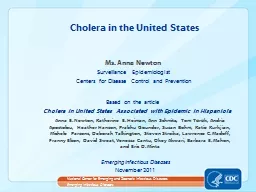

Centers for Disease Control and Prevention Cholera in the United States Emerging Infectious Diseases National Center for Emerging and Zoonotic Infectious Diseases Emerging Infectious Diseases ID: 910661
Download Presentation The PPT/PDF document "Ms. Anna Newton Surveillance Epidemiolog..." is the property of its rightful owner. Permission is granted to download and print the materials on this web site for personal, non-commercial use only, and to display it on your personal computer provided you do not modify the materials and that you retain all copyright notices contained in the materials. By downloading content from our website, you accept the terms of this agreement.
Slide1
Ms. Anna Newton
Surveillance EpidemiologistCenters for Disease Control and Prevention
Cholera in the United States
Emerging Infectious Diseases
National Center for Emerging and Zoonotic Infectious Diseases
Emerging Infectious Diseases November 2011
Based on the article Cholera in United States Associated with Epidemic in Hispaniola
Anna E. Newton, Katherine E.
Heiman,
Ann
Schmitz, Tom
Török
, Andria
Apostolou
, Heather
Hanson,
Prabhu
Gounder
, Susan
Bohm
, Katie
Kurkjian
, Michele
Parsons, Deborah
Talkington
,
Steven
Stroika
, Lawrence
C. Madoff,
Franny
Elson, David
Sweat,
Venessa
Cantu,
Okey
Akwari
, Barbara E.
Mahon, and
Eric D.
Mintz
Slide2What was the study about
?The study summarized the United States’ cases of cholera between October 2010 and April 2011 that were associated with the cholera epidemic in Haiti and the Dominican Republic, a region which is also known as
Hispaniola.
Because of epidemic, the United States enhanced monitoring and notification for cholera.
Slide3Why was the study done?
Cholera is a major cause of epidemic diarrhea throughout the developing world.
However, cholera is rare in the United States.During 2000-2009,
1-8 cases of cholera were diagnosed each year among people returning or coming from cholera-affected countries.When cholera breaks out in an area, people who travel there from the United States can get infected.
Back in the 1990s, over 100 people in the US became ill with cholera after traveling to Latin America during a cholera outbreak there.
Slide4What was found in the study?
23 cases of cholera in the United States from October 2010 to April 2011
13 patients reported travel to Haiti, and 9 to the Dominican Republic.The main reason for travel was to visit friends and family.
1 patient reported eating conch, a type of shellfish, brought back by a family member from Haiti.
Slide5What importance do the findings have for people living in the United States?
People traveling to areas where cholera is occurring may be exposed to the cholera bacteria and should take appropriate prevention measures while abroad so they don’t get
diarrheaPeople with severe diarrhea who have just come back from traveling to an area with cholera should be sure to tell their doctor they have been in a country where they could have gotten
cholera
Slide6How can people protect themselves from getting cholera when traveling?
Cholera is transmitted through contaminated food and water
Prevention measures for travelers Drink safe waterSafe water is water that has been boiled, carbonated, or disinfected. This includes only using ice that is made from safe water
Wash hands often with soap and safe water
When consider what food to eat, a good rule of thumb: ‘boil it, cook it, peel it, or forget it’People should cook food well, keep it covered, and eat it hotWhen preparing food, wash (using safe water) and peel fruits and vegetables
Avoid eating fresh salads or raw seafoodDon’t bring back food in luggage, especially seafoodThese same measures will also help to protect travelers form getting other types of diarrhea
Slide7For more information, please contact:
Emerging Infectious DiseasesCenters for Disease Control and Prevention
1600 Clifton Road NE, Mailstop D61, Atlanta, GA 30333, USA
Telephone: 1-404-639-1960/Fax: 1-404-639-1954E-mail: eideditor@cdc.gov Web: http://www.cdc.gov/eid/
The findings and conclusions in this report are those of the authors and do not necessarily represent the official position of the Centers for Disease Control and Prevention.
National Center for Emerging and Zoonotic Infectious DiseasesEmerging Infectious Diseases
Thank you to all authorsAnna E. Newton, Katherine E. Heiman, Ann Schmitz, Tom Török, Andria Apostolou, Heather Hanson, Prabhu Gounder, Susan Bohm, Katie Kurkjian, Michele Parsons, Deborah Talkington, Steven Stroika, Lawrence C. Madoff, Franny Elson, David Sweat, Venessa Cantu, Okey Akwari, Barbara E. Mahon, and Eric D. Mintz